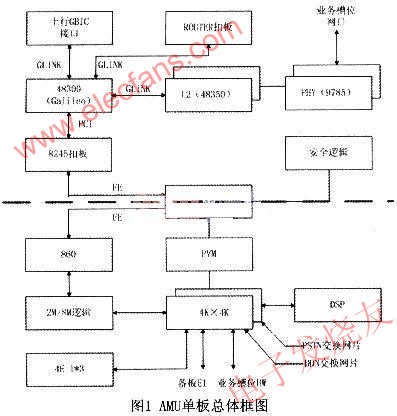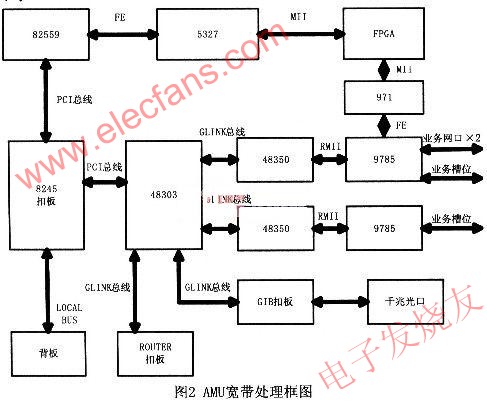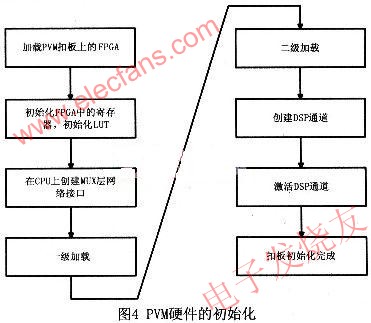The SYS6K system fully integrates narrowband circuit technology, NGN packet technology and broadband technology, and provides a solution for an integrated service access platform for NGN and PSTN. The SYS6K integrated access media gateway complies with the People's Republic of China communication industry standard YD / T1243.3-2002. The packet voice processing module designed in this paper is the functional module that completes the conversion between PCM code stream and IP data and part of the media protocol processing on the integrated access media gateway.
1SYS6K system design requirements
SYS6K is a large-capacity access media gateway that can provide integrated service access, providing functions such as analog user access, ADSL access, VDSL access, and SHDSL access. For analog user access, the access method provides both an E1 interface to access the traditional PSTN switch and a 10M / 100M / 1000M Ethernet port to access the IP network.
Carrying traditional voice over IP is an inevitable trend, and now major operators are also launching NGN projects. Therefore, products that can meet the current PSTN business requirements and achieve a smooth transition to NGN are exactly what operators expect. The SYS6K solution provides the compatibility of the above two methods mainly based on the business requirements of the bureau. The packet voice processing module is a functional module on the main control board. The selection of whether to match or not depends on whether to choose El or VoIP according to the data upstream. Its function is mainly to complete voice processing and provide analog voice to IP packets. Convert. Early media gateway development, complete the required signal processing, signaling, packaging and control functions, and send compressed or uncompressed VolP messages (IP voice packets).
AMU is the main control board of IONEAX6000 integrated access media gateway. It is the main part to realize the function of media gateway. It consists of narrowband voice exchange and broadband data exchange. The narrowband voice exchange part is composed of CPU control unit, E1 interface unit, HW time slot exchange unit, security logic unit, VoIP unit and DSP unit. The broadband data exchange part is composed of CPU control unit, GALILEO two-layer exchange chip and Gigabit optical interface. The CPU processor of the narrowband voice exchange part completes the functions of MGCP processing, narrowband service management, connection control, external serial port management, and master-slave control. The E1 interface unit completes the conversion of the 2MPCM code stream to 8MHW, and extracts the narrowband working reference clock from the PCM code stream. The HW time slot exchange unit is composed of two IDT72V70840, which can provide PSTN telephone voice exchange and DDN data exchange. These two services are processed independently in two network slices. The security logic unit implements narrowband clock processing, classifies and limits the data of the VoIP module and CPU, and replaces the MAC address and IP address. The VoIP module completes the conversion between HW signals and IP data streams, and realizes the transmission of traditional PSTN voice signals on InterNet, which can make IONEAX6000 smoothly transition from traditional access equipment to NGN equipment. The DSP unit completes standard signal tone transmission and number collection detection.
2 Analysis of packet voice processing module
VoIP is basically divided into two parts according to its functions. One is voice codec, which is compression and decompression, and the other is IP packets to send and receive voice information. The function of the packet voice processing module (PVM) is to realize the conversion between PCM code stream and IP data and media defense processing. It is used as a function module of the main control board in the system in the form of a daughter board. In the entire system, the main control board realizes the control of services, such as call establishment, management, and shutdown. The main control board also needs to manage and configure this module, as the sub-board is always controlled in the system. In addition, each reset requires the main control board to load configuration words, so the fault handling and resetting of this module are determined by the main control board, and cannot be reset by the daughterboard itself. Therefore, the relationship with the main control board is controlled at any time, and its signal direction is interspersed with the broadband and narrowband parts of the main control board.
3 Integrated access media gateway SYS6K solution
SYS6K is a frame-type integrated structure, which integrates functions such as analog user access, ADSL access, VDSL access, and SHDSL access. It is composed of a power board PTU, a main control board AMU, and a business board ALU. ADU, VDU, IVD, SDU, etc. The packet voice processing module PVM is a functional optional buckle board on the main control board AMU.
The broadband data part of the CPU system uses Motorola's 8245 CPU system, which provides a 32-bit PCI interface and LOCALBUS interface. The PCI bus can support 5 devices. The 8245 can configure GALILEO 48303 through the PCI bus, and then realize the data exchange for each business network port, upstream Gigabit optical port, and routing module through the GUNK bus defined by GALILEO. The overall block diagram of the AMU board is shown in Figure 1.

3.1 Narrowband voice exchange section
The narrowband voice exchange part completes the functions of access to PSTNEl signals, conversion between E1 and PCM signals, exchange between PCM time slots, conversion between PCM voice and IP data streams, security logic, etc. The main signal flow is that the E1 chip receives the E1 signal from the PSTN network, extracts the 2M clock signal as the reference clock of the entire narrowband system, and generates the clock and frame synchronization signals required by each chip. At the same time, after the E1 signal sent by the PSTN network passes through the E1 chip, the encoding type is converted from HDB3 to NRz, and then sent to the network chip for PCM time slot exchange, sent to each user board, or sent to the PVM daughter board for processing. Since the system itself also provides analog users to access the PSTN network, in the TDM interface part, the main control board AMU and the narrowband service board ALU have completed the conversion of analog signals to digital signals. There are two processing channels for the voice service, access to the PSTN switch or other relay equipment through the E1 interface of the system, or through the packet voice processing module into IP packets. The system design has already fed into PVM is Highway of PCM signal.
3.2 Broadband data processing part
The broadband data exchange part completes the basic configuration of various access methods, Ethernet switching and Ethernet management functions. The block diagram of the broadband structure is shown in Figure 2.

The system has rich broadband services and powerful broadband processing functions. For PVM, due to the optional functional module design on the main control board, considering the consistency of the system interface, it cannot provide external service interfaces, so it can only rely on Connect to the upstream port on the AMU.
4 packet voice processing module design
Packet voice processing module is a very critical part of VoIP products. VoIP voice dedicated IC is divided into two parts: voice codec and packet processing. This article integrates SYS6K function and performance requirements, and finally analyzes the situation of several optional chips, and finally selects the solution of BroADCom. Choose the scheme that Broadcom's CalistoBCMl510 cooperates with FPGA. Because the BCMl510 single chip has the processing capacity of 190 channels 6711, 128 channels 6711 + T.38, 96 channels 6711 + T.38, it is more suitable for the large capacity requirements of SYS6K, the power consumption is also smaller, and can be selected and reset by a single chip , Which can basically meet the capacity requirements of the system with full allocation, but also bring good flexibility to the business capacity and type, and can easily achieve multi-specification design. 1510 completes voice codec and data packaging, but because SPICEBUS belongs to Broadcom special protocol, FPGA must be used as SPICEBRIDGE to complete the bridging function, and then sent to the business network port through the Switch chip. The overall structure is shown in Figure 3.

5 hardware initialization design analysis
The PVM daughterboard driver is mainly responsible for completing hardware initialization, kernel loading, completing the drive of the PVM daughterboard, and controlling the PVM daughterboard to complete various operations.
Initializing the PVM daughterboard is mainly to set the hardware information of the PVM daughterboard and load the kernel program to Calisto. BCMl510. According to the initialization process is divided into several parts as shown in Figure 4.

(1) Load the FPGA on the PVM board, namely SPICEBRIDGE. SPICEBRIDGE realizes the conversion between the control message of the CPU and the CELL of CALISTOBCMl510. Only when SPICEBRIDGE works normally, the PVM module can proceed to the next step.
(2) Initialize the LUT and registers on the FPGA.
(3) Create a MUX layer network interface on the CPU to prepare for communication between the CPU and CALISTOBCMl510.
(4) First-level loading of CALIST0BCMl510. The first-level loading is automatically implemented by SPICEBRIDGE. The driver only needs to put the kernel file in the specified location in SDRAM under SPICEBRIDGE, and start SPICEBRIDGE to perform the first-level loading.
(5) Second-level loading of CalistoBCMl510. The second-level loading is done by the CPU through the MUX layer network interface and transferring the loading kernel to CalistoBCMl510.
(6) Create a channel. Create a certain number of channels (usually 480) in advance on CalistoBCMl510.
(7) Activate the channel. After the channel is created, it must be activated before it can be used.
6 Conclusion
This paper completes the hardware circuit design of the packet voice processing module PVM that can cooperate with the main control device and put it into production. It can be applied to multiple access gateway and relay gateway devices to reduce the cost of the original packet voice processing module , To increase the system processing capacity, after hardware commissioning and hardware-software joint commissioning has been actually applied to the integrated access media gateway.
Pedal Dustbin,Stainless Steel Pedal Dustbin,Stainless Steel Foot Pedal Dustbin,Pedal Toilet Dustbin
NINGBO ZIXING ELECTRONIC CO.,LTD. , https://www.zixingautobin.com